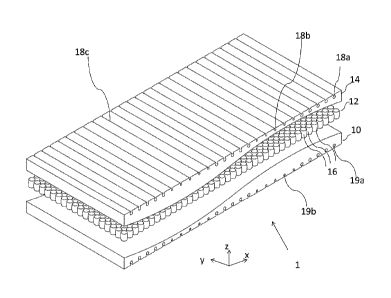Some of the information on this Web page has been provided by external sources. The Government of Canada is not responsible for the accuracy, reliability or currency of the information supplied by external sources. Users wishing to rely upon this information should consult directly with the source of the information. Content provided by external sources is not subject to official languages, privacy and accessibility requirements.
Any discrepancies in the text and image of the Claims and Abstract are due to differing posting times. Text of the Claims and Abstract are posted:
| (12) Patent: | (11) CA 3053856 |
|---|---|
| (54) English Title: | MATTRESS |
| (54) French Title: | MATELAS |
| Status: | Granted |
| (51) International Patent Classification (IPC): |
|
|---|---|
| (72) Inventors : |
|
| (73) Owners : |
|
| (71) Applicants : |
|
| (74) Agent: | BROUILLETTE LEGAL INC. |
| (74) Associate agent: | |
| (45) Issued: | 2021-09-28 |
| (86) PCT Filing Date: | 2017-11-09 |
| (87) Open to Public Inspection: | 2018-08-23 |
| Examination requested: | 2019-08-16 |
| Availability of licence: | N/A |
| (25) Language of filing: | English |
| Patent Cooperation Treaty (PCT): | Yes |
|---|---|
| (86) PCT Filing Number: | PCT/EP2017/078812 |
| (87) International Publication Number: | WO2018/149523 |
| (85) National Entry: | 2019-08-16 |
| (30) Application Priority Data: | ||||||
|---|---|---|---|---|---|---|
|
The invention relates to a mattress (1, 1', 2, 3) having at least one first layer (10, 20, 30), a second layer (12, 22, 32) and a third layer (14, 24, 34), the second layer (12, 22, 32) comprising spring elements (16, 26, 36) and being interposed between the first layer (10, 20, 30) and the third layer (14, 24, 34). The thickness (a1, a2, a3, d1, d2, d3,..., d10) of the third layer (14, 24, 34) varies locally to an extent that exceeds the extent defined by a surface structure of the third layer (14, 24, 34) on its exterior surface (17).
L'invention concerne un matelas (1, 1', 2, 3) comportant au moins une première couche (10, 20, 30), une deuxième couche (12, 22, 32) et une troisième couche (14, 24, 34), la deuxième couche (12, 22, 32) comprenant des éléments ressort (16, 26, 36) et étant agencée entre la première couche (10, 20, 30) et la troisième couche (14, 24, 34). L'épaisseur (a1, a 2, a 3, d1, d2, d3,..., d10) de la troisième couche (14, 24, 34) varie localement d'une dimension qui dépasse la dimension qui est prédéfinie par une structure de surface de la troisième couche (14, 24, 34) au niveau de sa surface extérieure (17).
Note: Claims are shown in the official language in which they were submitted.
Note: Descriptions are shown in the official language in which they were submitted.

For a clearer understanding of the status of the application/patent presented on this page, the site Disclaimer , as well as the definitions for Patent , Administrative Status , Maintenance Fee and Payment History should be consulted.
| Title | Date |
|---|---|
| Forecasted Issue Date | 2021-09-28 |
| (86) PCT Filing Date | 2017-11-09 |
| (87) PCT Publication Date | 2018-08-23 |
| (85) National Entry | 2019-08-16 |
| Examination Requested | 2019-08-16 |
| (45) Issued | 2021-09-28 |
There is no abandonment history.
Last Payment of $210.51 was received on 2023-10-25
Upcoming maintenance fee amounts
| Description | Date | Amount |
|---|---|---|
| Next Payment if standard fee | 2024-11-12 | $277.00 |
| Next Payment if small entity fee | 2024-11-12 | $100.00 |
Note : If the full payment has not been received on or before the date indicated, a further fee may be required which may be one of the following
Patent fees are adjusted on the 1st of January every year. The amounts above are the current amounts if received by December 31 of the current year.
Please refer to the CIPO
Patent Fees
web page to see all current fee amounts.
| Fee Type | Anniversary Year | Due Date | Amount Paid | Paid Date |
|---|---|---|---|---|
| Request for Examination | $800.00 | 2019-08-16 | ||
| Application Fee | $400.00 | 2019-08-16 | ||
| Maintenance Fee - Application - New Act | 2 | 2019-11-12 | $100.00 | 2019-08-16 |
| Maintenance Fee - Application - New Act | 3 | 2020-11-09 | $100.00 | 2020-10-14 |
| Final Fee | 2021-07-02 | $306.00 | 2021-06-07 | |
| Maintenance Fee - Patent - New Act | 4 | 2021-11-09 | $100.00 | 2021-11-02 |
| Maintenance Fee - Patent - New Act | 5 | 2022-11-09 | $203.59 | 2022-10-27 |
| Maintenance Fee - Patent - New Act | 6 | 2023-11-09 | $210.51 | 2023-10-25 |
Note: Records showing the ownership history in alphabetical order.
| Current Owners on Record |
|---|
| VANEMA D.O.O. |
| Past Owners on Record |
|---|
| None |